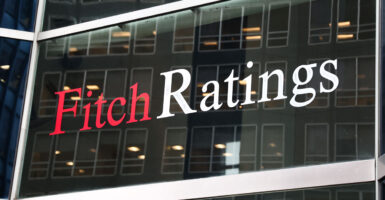Fitch Ratings downgraded the U.S. government’s credit rating from “AAA” to “AA+” on Tuesday, a signal that the agency no longer has complete confidence in the government’s ability to avoid default.
The rating “reflects the expected fiscal deterioration over the next three years, a high and growing general government debt burden, and the erosion of governance … that has manifested in repeated debt limit standoffs and last-minute resolutions.”
The ratings downgrade will increase federal borrowing costs, and it undermines the narrative that the economy is currently flourishing.
“There has been a steady deterioration in standards of governance over the last 20 years,” Fitch stated. “The repeated debt-limit political standoffs and last-minute resolutions have eroded confidence in fiscal management.”
It also cited no “medium-term fiscal framework,” “successive debt increases,” and “only limited progress in tackling” the impending fiscal cliff of Social Security and Medicare insolvency.
Fitch projected the U.S. government will run a deficit of more than 6% over the next three fiscal years. As a result, it projected that the interest-to-revenue ratio (the amount of its total income the U.S. government must pay in interest on its debt) will reach 10% by 2025. By comparison, it noted that the median government with a “AAA” or “AA” rating has a 1% or 2.8% interest-to-revenue ratio, respectively.
According to Federal Reserve data, federal government expenditures on interest payments have accelerated dramatically since January 2022, as the growing debt burden is refinanced at higher interest rates.
Two years after World War II, the U.S. government was paying a little over $5 billion annually to service the astronomical war debt (nearly $68 billion in today’s dollars). It was paying around $550 billion annually when Joe Biden became president in 2021 (roughly $616 billion today). Now, the U.S. government is paying an annual $970 billion in interest on its debt.
Fitch also knocked the U.S. government for its bloated debt-to-gross domestic product ratio, which stands at 112.9% this year, “well above the pre-pandemic 2019 level of 100.1%.” It projected it would rise to 118.4% by 2025. By contrast, the debt-to-GDP ratio for the median “AAA” or “AA” government was 39.3% and 44.7%, respectively.
Fitch doesn’t expect the government’s fiscal situation to improve for several years. “Over the next decade, higher interest rates and the rising debt stock will increase the interest service burden, while an aging population and rising healthcare costs will raise spending on the elderly absent fiscal policy reforms,” it noted.
To make matters worse, it projected the U.S. economy will descend into a “mild recession” this winter, and that the Federal Reserve has not yet completely cornered inflation, leaving a weak economy to support this growing debt burden.
The credit downgrade comes as the president attempts to persuade Americans on the success of his “Bidenomics” policies in speeches delivered on June 28, July 6, and July 20, as well as other extemporaneous comments.
Biden is trying to take credit for low unemployment and declining inflation, thus persuading Americans of the economic success of his spending packages.
Yet Fitch has projected a recession within months and ongoing interest rate hikes to address persistent inflation troubles. It also despaired of a near-term solution to the U.S. government’s deficit spending or the impending entitlements insolvency.
Fitch is one of the “Big Three” credit rating agencies, along with Standard & Poor’s and Moody’s. Fitch is controlled by the Hearst Communications empire. “Diversity, equity and inclusion are at the core of Hearst’s approach to building a stronger company, a thriving culture and quality products,” states the company’s website.
Hearst advertises seven DEI initiatives within the Fitch Ratings agency, including a Fitch Pride Network, which focuses on “helping Fitch become an employer of choice to diverse individuals” and broadening “awareness of issues the LGBTQAI+ community faces.”
The U.S. has enjoyed a “AAA” with Fitch since 1994. While Moody’s still rates U.S. credit as “AAA,” S&P downgraded U.S. credit to “AA+” after a tense debt limit standoff in 2011. A smaller rating agency called Egan-Jones downgraded U.S. credit three times in 2011-2012 (down to “AA,” then “AA-“), while the China-controlled Dagong Global Credit Rating downgraded the U.S. from “A” to “A-” in 2013.
Fitch’s downgrading comes even after the Securities and Exchange Commission retaliated against S&P and Egan-Jones for their downgrades.
Despite the downgrade from “AAA” to “AA+,” the U.S. still boasts an excellent credit rating. Ratings agencies use a complicated system that rates credit risk in the following order: AAA, AA, A, BBB, BB, B, CCC, CC, C, and D (reserved for bonds and securities in default). Intermediate steps are distinguished with a “+” or “-” that play a role similar to sharp and flat symbols in music.
However, the slight downgrade can still produce substantial ripples throughout the economy, and for the federal government in particular.
A credit rating reflects the rating agency’s level of confidence that a debtor (in this case, the U.S. government) will pay all its bills on time. Even a slight downgrade in the level of confidence placed on government debt can affect investor confidence throughout the stock market; on Wednesday, the Dow Jones fell 1%, the S&P 500 fell 1.4%, and the Nasdaq fell 2.2% in its worst performance since February.
Reduced confidence that the government will pay back its debt also increases the risk of those who hold that debt, who will demand a higher interest rate as compensation.
A slight ratings downgrade may only raise U.S. interest rates slightly, but this could substantially raise federal expenditures on interest when multiplied across the government’s $32 trillion in debt. Further impacts of the ratings downgrade may only become evident over time.
Originally published by The Washington Stand
Have an opinion about this article? To sound off, please email letters@DailySignal.com and we’ll consider publishing your edited remarks in our regular “We Hear You” feature. Remember to include the url or headline of the article plus your name and town and/or state.

























